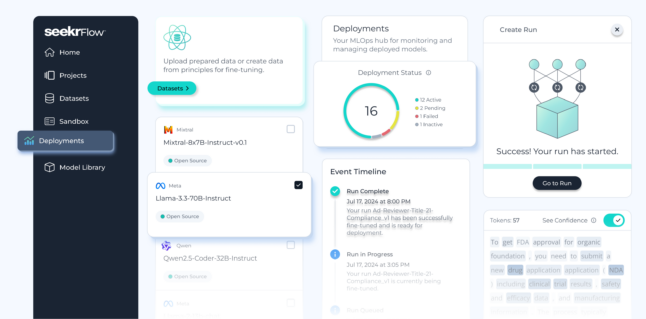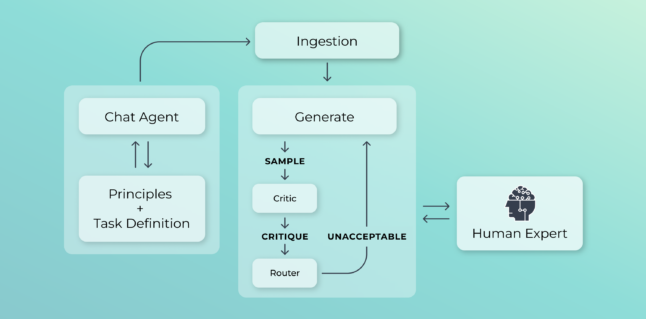Key takeaways
- Agentic AI is poised to change the world—and it’s coming fast. How we live and work will transform dramatically in the next few years, not decades.
- This new approach will allow AI to act autonomously. Agentic AI combines large language models (LLMs), data sources, and software tools into intelligent systems that act without human input.
- Enterprises will need agentic AI to stay relevant. Agentic AI can solve complex business problems and automate sophisticated, multistep tasks. These capabilities will redefine how enterprises operate.
- Seekr is pioneering the agentic era. Our end-to-end platform for trusted AI, SeekrFlow™, includes an agentic system that dramatically reduces training data preparation time and costs.
The promise of agentic AI
What if you could rely on AI as if it were a member of your team?
That’s the promise of agentic AI, the next phase of AI evolution—which boasts enough world-changing potential that journalists are calling it the new electricity.
But don’t mistake agentic AI as a far-off possibility. In a recent survey, 82% of large enterprise leaders report they plan to deploy AI agents in the next three years. And with good reason: agentic capabilities allow AI to evolve from chatbots and question and answer systems to become autonomous problem solvers equipped to reason and act on their own.
Learn about SeekrFlow’s agentic system for faster data creation
Learn MoreWhat is agentic AI?
Agentic AI integrates advanced LLMs, data sources, and software tools into an agentic system that can do much more than traditional AI.
In these systems, one or more LLMs coordinate among themselves and a number of other components, including search functions, calculators, or business-specific applications. In some frameworks, a hub model acts as a group manager. Agentic systems rely on LLMs’ ability to understand data and human intent to drive the connected system, accessing data and tools as needed.
As thinking, sensing, acting entities, agentic AI systems can proactively pursue objectives in whatever way they see fit—with minimal human guidance. These systems can also evaluate and refine their own work. The result is AI that independently solves complex, multipart problems by taking advantage of external data and tools.
In contrast, the current standard for enterprise AI is a single application, such as a chatbot or AI assistant, that provides responses based on user prompts and leads to user action rather than agent action. When the AI isn’t prompted, it doesn’t take any action. Many stand-alone models can’t pull in additional information or identify the need for it. They also can’t perform many operations beyond next-token generation. For example, ChatGPT can generate a marketing email, but it can’t intelligently schedule the email based on the recipient’s calendar availability or dynamically refine the content based on customer journey data from a CRM platform.
How does agentic AI work?
Conceptually, agentic AI solutions are built on three core capabilities:
- Rational-adjacent problem-solving: Agentic AI can process information and generate solutions in ways that closely mimic human reasoning and critical thinking. This allows agentic AI to handle complex, evolving scenarios without human intervention.
- Action: Agentic AI can do more than just figure out the scenario and optimal path forward—it can pursue that path through a variety of actions. Imagine AI actually deploying and testing a prototype application instead of just generating the code.
- Memory: While traditional LLMs rely on conversation histories to inform their prompted responses, agentic AI goes a step further by continually referencing and building upon computational logs to enable self-improvement loops.
Today, there are a number of offerings available that allow enterprises to start exploring agentic AI and agentic workflows, including LangGraph and CrewAI.
Agentic use cases at the nexus of intelligence and creativity
According to a Capgemini survey of 1,100 executives at large enterprises, just 10% of enterprises are using AI agents today. More than half of respondents indicate they anticipate using them in the next year.
Overall, agentic AI systems will enable enterprises to apply intelligent automation to even more aspects of their business. In doing so, they can realize higher levels of optimization and further free up staff time for their most critical responsibilities. According to Gartner, by 2028, approximately one-third of enterprise software will include agentic AI, which will allow for 15% of daily decision-making to happen autonomously.
Beyond mere automation, however, the possibilities of agentic AI are vast. Across industries, agentic AI can be applied in creative ways to unlock innovative new use cases:
- For complicated economic workflows like insurance and loan underwriting, AI agents could evaluate external databases, market indices, and real-world news cycles to handle claims and applications with a speed and thoroughness way beyond human capability, helping day-to-day business move even faster.
- In software development, AI agents could write and rewrite code to create new applications or modify existing ones, perhaps in response to user-reported bugs or feature requests. This could result in a veritable Cambrian explosion of new apps or revived projects.
- In media and entertainment, AI agents could be programmed into video game characters and engage players with improvised actions and dialogue. This could lead to completely new paradigms for immersion and imagination.
Trustworthiness is a foundational requirement
As with any new technology, managing risks and ensuring security is critical to agentic AI adoption, especially when agentic decision-making can impact business workflows and your organization’s reputation. New levels of autonomy and control introduce a myriad of safety concerns that need to be addressed through strong governance, data management, and cybersecurity practices to help mitigate risks.
Validation and testing alongside continuous monitoring are also essential to rolling out real-world agent capabilities. With these guardrails in place, organizations can be well positioned to make the most of agentic AI.
Embracing the potential of agentic AI transformation
The world may not be ready for agentic AI, but we are. If you’re developing agentic AI systems today, Seekr can help you deliver the customized LLM capabilities you need to power your business applications and services.
Our AI platform, SeekrFlow, includes an agentic system for rapidly transforming vast amounts of data into custom AI models. The feature, Principle Alignment, autonomously generates a tailor-made training dataset with just a few user inputs, which dramatically streamlines tasks such as feature engineering and model fine-tuning.
While the technology is still developing, enterprise agentic AI will soon become an integral part of remaining competitive and staying relevant. The SeekrFlow platform allows enterprises to harness the power of agentic systems today to gain a competitive edge through dramatically simplified dataset creation and preparation.
To learn more about how SeekrFlow greatly accelerates data prep—and accelerates time to value for LLMs—check out this blog post from Nick Sabharwal, our VP of product.




